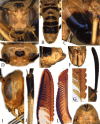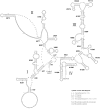Characterization of the mitochondrial genome of Arge bella Wei & Du sp. nov. (Hymenoptera: Argidae)
- PMID: 30595984
- PMCID: PMC6305119
- DOI: 10.7717/peerj.6131
Characterization of the mitochondrial genome of Arge bella Wei & Du sp. nov. (Hymenoptera: Argidae)
Abstract
We describe Arge bella Wei & Du sp. nov., a large and beautiful species of Argidae from south China, and report its mitochondrial genome based on high-throughput sequencing data. We present the gene order, nucleotide composition of protein-coding genes (PCGs), and the secondary structures of RNA genes. The nearly complete mitochondrial genome of A. bella has a length of 15,576 bp and a typical set of 37 genes (22 tRNAs, 13 PCGs, and 2 rRNAs). Three tRNAs are rearranged in the A. bella mitochondrial genome as compared to the ancestral type in insects: trnM and trnQ are shuffled, while trnW is translocated from the trnW-trnC-trnY cluster to a location downstream of trnI. All PCGs are initiated by ATN codons, and terminated with TAA, TA or T as stop codons. All tRNAs have a typical cloverleaf secondary structure, except for trnS1. H821 of rrnS and H976 of rrnL are redundant. A phylogenetic analysis based on mitochondrial genome sequences of A. bella, 21 other symphytan species, two apocritan representatives, and four outgroup taxa supports the placement of Argidae as sister to the Pergidae within the symphytan superfamily Tenthredinoidea.
Keywords: Arge bella; Cladistic analysis; Mitochondrial genome; New species; Secondary structure; Taxonomy.
Conflict of interest statement
The authors declare there are no competing interests.
Figures







Similar articles
-
Complete mitochondrial genome sequence of Labriocimbex sinicus, a new genus and new species of Cimbicidae (Hymenoptera) from China.PeerJ. 2019 Oct 7;7:e7853. doi: 10.7717/peerj.7853. eCollection 2019. PeerJ. 2019. PMID: 31608181 Free PMC article.
-
Characterization of the mitochondrial genome of Analcellicampa xanthosoma gen. et sp. nov. (Hymenoptera: Tenthredinidae).PeerJ. 2019 May 2;7:e6866. doi: 10.7717/peerj.6866. eCollection 2019. PeerJ. 2019. PMID: 31106070 Free PMC article.
-
Next-Generation Sequencing of Two Mitochondrial Genomes from Family Pompilidae (Hymenoptera: Vespoidea) Reveal Novel Patterns of Gene Arrangement.Int J Mol Sci. 2016 Oct 11;17(10):1641. doi: 10.3390/ijms17101641. Int J Mol Sci. 2016. PMID: 27727175 Free PMC article.
-
The complete mitochondrial genome of Moricella rufonota Rohwer, 1916 (Hymenoptera: Tenthredinidae) and phylogenetic analysis.Mitochondrial DNA B Resour. 2021 Jul 12;6(8):2285-2287. doi: 10.1080/23802359.2021.1920859. eCollection 2021. Mitochondrial DNA B Resour. 2021. PMID: 34291162 Free PMC article.
-
Characterization of the complete mitochondrial genome of Tryporyza incertulas, in comparison with seven other Pyraloidea moths.Gene. 2014 Jan 1;533(1):356-65. doi: 10.1016/j.gene.2013.07.072. Epub 2013 Aug 15. Gene. 2014. PMID: 23954873
Cited by
-
Phylogenomic Analyses of the Tenthredinoidea Support the Familial Rank of Athaliidae (Insecta, Tenthredinoidea).Insects. 2022 Sep 21;13(10):858. doi: 10.3390/insects13100858. Insects. 2022. PMID: 36292806 Free PMC article.
-
Complete mitochondrial genome sequence of Labriocimbex sinicus, a new genus and new species of Cimbicidae (Hymenoptera) from China.PeerJ. 2019 Oct 7;7:e7853. doi: 10.7717/peerj.7853. eCollection 2019. PeerJ. 2019. PMID: 31608181 Free PMC article.
-
The mitochondrial genome of the semi-slug Omalonyx unguis (Gastropoda: Succineidae) and the phylogenetic relationships within Stylommatophora.PLoS One. 2021 Jun 25;16(6):e0253724. doi: 10.1371/journal.pone.0253724. eCollection 2021. PLoS One. 2021. PMID: 34170937 Free PMC article.
-
Characterization of the mitochondrial genome of Analcellicampa xanthosoma gen. et sp. nov. (Hymenoptera: Tenthredinidae).PeerJ. 2019 May 2;7:e6866. doi: 10.7717/peerj.6866. eCollection 2019. PeerJ. 2019. PMID: 31106070 Free PMC article.
References
-
- Abe M, Smith DR. The genus-group names of Symphyta (Hymenoptera) and their type species. Esakia, Fukuoka. 1991;31:1–115.
-
- Benson RB. On the classification of sawflies (Hymenoptera Symphyta) The Transactions of the Royal Entomological Society of London. 1938;87(15):353–384.
-
- Cannone JJ, Subramanian S, Schnare MN, Collett JR, D’Souza LM, Du Y, Feng B, Lin N, Madabusi LV, Müller KM, Pande N, Shang Z, Yu N, Gutell RR. The comparative RNA web (CRW) site: an online database of comparative sequence and structure information for ribosomal, intron, and other RNAs. BMC Bioinformatics. 2002;3:1–31. doi: 10.1186/1471-2105-3-2. - DOI - PMC - PubMed
LinkOut - more resources
Full Text Sources

